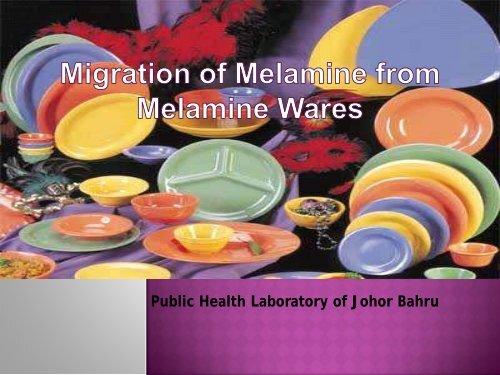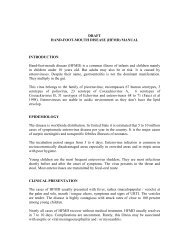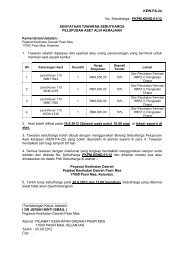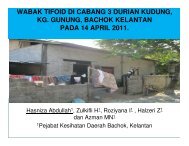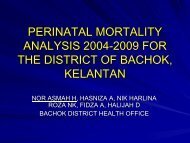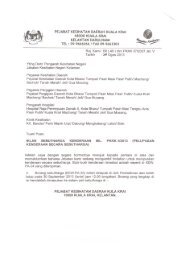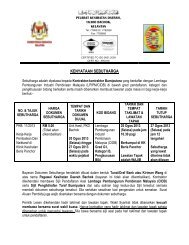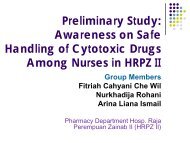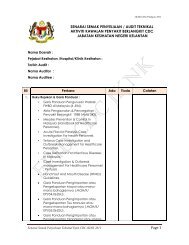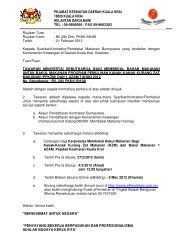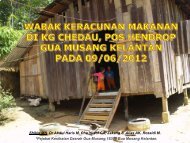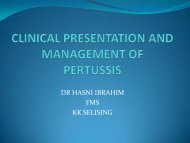Public Health Laboratory Of Johor Bahru
Public Health Laboratory Of Johor Bahru
Public Health Laboratory Of Johor Bahru
You also want an ePaper? Increase the reach of your titles
YUMPU automatically turns print PDFs into web optimized ePapers that Google loves.
<strong>Public</strong> <strong>Health</strong> <strong>Laboratory</strong> of <strong>Johor</strong> <strong>Bahru</strong>
Tableware made of melamine-formaldehyde resinsintended for repeated use is commonly known asmelamine-ware.
Melamine and formaldehyde are the chemicalbuilding blocks of the material used inmelamine-ware. After their manufacture, residual monomer canremain in the plastic and may migrate intofoodstuffs coming into contact with thatmaterial. Migration of residual monmoer from tablewareto foodstuffs is influenced by many factorsincluding the material of tableware, the type(aqueous, acidic, alcoholic or fatty) and nature(solid or liquid) of thefood, temperature, duration and area ofcontact.
Is there any migration of melamine frommelamine ware used in Malaysia?
To study the migration ofmelamine from melamineware into food simulants
1) To determine the migration of melaminefrom melamine wares using foodsimulants.2) To identify whether the migration ofmelamine into the food simulants exceedsEU limit.
In Europe, melamine is approved for use as amonomer and as an additive in plastics witha Specific Migration Limit (SML) of 30 mg/kg(Commission Directive EC No 2002/72 relatedto materials and articles intended to comeinto contact with foodstuffs from 6 August2002).
The EU Scientific Committee for Food (SCF)evaluated melamine in 1987 the tolerabledaily intake (TDI) for melamine wasestablished at 0.5 mg/kg bodyweight/day This values leads to currently SML of 30mg/kg food using the conventional procedureof the EU Commission taking in considerationa ‘standard EU citizen’ with a bodyweight of60 kg consuming 1 kg food/day.
Overseas surveys conducted by United KingdomFood Standards Agency (UKFSA) in 2004 and 2008reported melamine migration was below limits. 15 different items of kitchenware were testedfor migration into 3% acetic acid which was usedas the most aggressive food simulants towardsmelamine plastic. Most of the articles were tested at 70°C underrepeated-use conditions. Melamine was confirmed to migrate into theacetic acid simulant from 43 of the 50 surveysamples. None of the samples exceeded the SML of30 mg/kg (equivalent to 5 mg/dm 2 ).
Sampling size : 180 samples (3 units persample) Type of samples: Melamine ware, e.g.spoon, fork, dinner plate, tray, saucer Samples were sent by health inspectors fromall the health district offices in Malaysia.
Determination of 2,4,6-triamino-1,3,5-triazine in food simulants - EN 13130-27(European standard method) Basic rules necessary for testing migrationof the constituents of plastic materials andarticles intended to come into contact withfoodstuffs- 82/711/EEC. (for extraction) Simulants Used : water & 3% acetic acid Simulation condition: 70°C / 1 hour Instruments Used : FTIR Spectrometer &HPLC-UV/Vis
Samples were identified and confirmed asmelamine ware using FTIRSamples were filled with simulants andincubated at 70°C for 1 hourSimulants were injected into HPLC
Average Results of 3 No. of Samples forAcetic Water Acid Simulant SimulantReadingsWater Simulant(n = 180)(n = 180)No. of Samples forAcetic Acid Simulant(n = 180)59Not Detected(< LOQ)46134 (74.4%) 121 (67.2%)Not DetectedNot Detected (Detected (>NOTE : Specific Migration Limit 121 LOQ) (SML)= LOQ) 30 mg/kg134Limit of Quantitation (LOQ) = 0.6 mg/kg
Average Results of 3ReadingsNo. of Samples forWater Simulant(n = 180)No. of Samples forAcetic Acid Simulant(n = 180)≥ LOQ(≥ 0.6 mg/kg)46 (25.6%) 59 (32.8%)NOTE : Specific Migration Limit (SML)= 30 mg/kgLimit of Quantitation (LOQ) = 0.6 mg/kg
Average Results of 3ReadingsNo. of Samples forWater Simulant(n = 180)No. of Samples forAcetic Acid Simulant(n = 180)> SML(Non complyingsamples)0 (0%) 0 (0%)NOTE : Specific Migration Limit (SML)= 30 mg/kgLimit of Quantitation (LOQ) = 0.6 mg/kg
Types of SampleNo. of SamplesDetected inWater SimulantsResults (mg/kg)Tray -Glass & Cup 2 0.6 – 1.8Spoon 6 1.2 – 9.6Ladle 2 5.0 – 6.0Saucer 2 1.8 – 2.7Bowl 4 1.2 – 3.6Plate 30 0.6 – 10.4Cutlery set -Total 46
Types of SampleNo. of SamplesDetected inAcetic AcidSimulantResults (mg/kg)Tray 1 3.1Glass & Cup 3 0.6 – 6.6Spoon 4 1.0 – 27.6Ladle 1 1.0Saucer 6 0.6 – 26.4Bowl 7 0.6 – 26.0Plate 36 1.0 – 29.0Cutlery set 1 19.2Total 59
All the 180 samples tested were found to bebelow the Specific Migration Limit which is30 mg/kg. Generally melamine wares sold in Malaysianmarket are complying the EU limits for themigration of melamine (based on the samplesreceived).
However, If melamine ware is exposed toenough heat, melamine will decompose. For this reason, melamine ware should notbe exposed to high temperatures like thosein the oven and microwave. So it should not be used for cooking or to beheated in microwave or conventional oven.
EU Directive EC/2002/72 EN 13130-27


